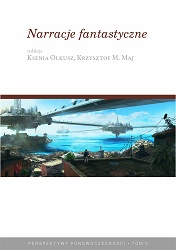Narracje transfikcjonalne na przykładzie serialu Once Upon A Time"
Transfictional Narratives: A Study of "Once Upon A Time"
Author(s): Ksenia Olkusz
Subject(s): Visual Arts, Theory of Literature
Published by: Ośrodek Badawczy Facta Ficta
Keywords: transfictionality;postclassical narratology;narrative studies;transfictional narratives;Disney;Disney storyworld;One Upon A Time
Summary/Abstract: The chapter by Ksenia Olkusz examines a TV show "One Upon a Time" (ABC Studios 2011-now) in terms of so-called transfictional world-building. As Richard Saint-Gelais has observed, a transfictional relation occurs when “two (or more) texts share elements such as characters, imaginary locations, or fictional worlds”, at least as long as there are no direct intertextual indication of this connection. This “one world-many texts” relation, as Marie-Laure Ryan terms transfictionality, seems to be inevitable when one can explore a fictional world in a manner proposed by the writers of OUAT who decided to take characters from a multitude of fairy tales, legends, and, particularly, Disney animations so as to assemble them all in the one coherent multiverse. What really matters in OUAT is a “transfictional impulse” that attracts addressees not necessarily with an engaging plot but by concealing intertextual links to the source material which remains clouded by retelling, renarration, or cross-over strategies. Therefore, ABC series clearly demands a specific kind of foreknowledge which makes the TV series particularly appealing for seasoned (pun intended) viewers—those able and willing to enjoy retold or redefined fictional biographies, clashes of aesthetically inconsistent worlds (or word dimensions), or even mash-ups of childhood fairy tales with contemporary franchised universes. The latter of the mentioned phenomena has even gotten beyond a TV show storyline when those transfictional qualities were embedded in posters advertising succeeding OUAT seasons—all designed to evoke a familiar aesthetics of not only Disney movies (like for instance, Frozen or Brave), but also mainstream movies (such as a Black Swan) or other TV shows and literary fiction (The Song of Ice and Fire in particular). The chapter explores all the aforementioned phenomena, delivering one of the first meticulous renditions of transfictional theory in Poland.
Book: Narracje fantastyczne
- Page Range: 81-113
- Page Count: 67
- Publication Year: 2017
- Language: Polish
- Content File-PDF

